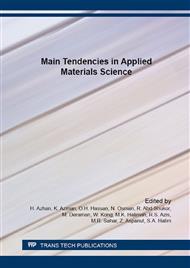p.149
p.154
p.161
p.172
p.177
p.183
p.189
p.193
p.199
The Effect of PbO on the Physical and Structural Properties of Borate Glass System
Abstract:
Borate is one of the most popular oxide glass being used in glass research world wide. Due to good reputation, therefore lead sodium borate glasses with compositions (90 - x) B2O3 + 10ZnO + xPbO (where = 15, 20, 25, 30 and 35 mol %) have been prepared by using melt-quenching method. In this work, their physical and structural properties with respect to PbO content has been investigated. The densities of these glass samples were increased from 3946.2 kg/m3 to 5107.2 kg/m3 with an increase in PbO concentration. The molar volume are found to vary from 23.78 × 10-6 m3mol-1 to 24.39 × 10-6 m3mol-1 with respect to PbO content as well. The density and molar volume show inversed result respectively. The FTIR spectral analysis indicates that with the addition of PbO contents in the glass network, structural units of BO3 are transformed in BO4. There are no sharp peaks were observed in XRD patterns of the glass samples which confirmed the amorphous nature of the glass. Meanwhile, the micro hardness of these glass samples were also increased from 189 Pa to 355 Pa with increases on PbO content. The results will be discussed and presented in details.
Info:
Periodical:
Pages:
177-182
Citation:
Online since:
March 2016
Authors:
Keywords:
Price:
Сopyright:
© 2016 Trans Tech Publications Ltd. All Rights Reserved
Share:
Citation:


